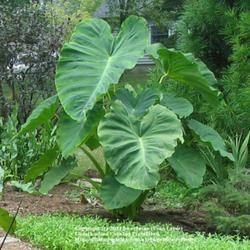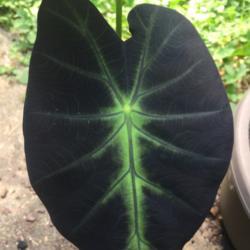In the 5 month growing season here the largest tubers of the type I have produce 6'+H plants with leaves around 3'L. I plant in late May and lift after the frost has knocked them down (usually mid-October). They do fine in full sun to part shade but do best with lots of water. The newer leaves seem to have more marbling in part sun/shade. I also don't believe you can feed them too much. Easy to store dry over winter while dormant.

Great colors and form and it likes full sun here. This year, 2012, they reached 5 feet plus and produced loads of pups close to the crown. The parent tuber rotted after potting up for overwintering 2011-12. Three pups survived and were potted up. Two were then planted in ground in mid-May. Both produced tubers large enough to overwinter,...hopefully.

While my Jack's haven't reached their full potential this year, they never fail to bring on a smile. On two plants the 4th leaf to emerge was over 3 feet long, easily living up to its name. They've been happy exposed to mostly sun as well as bright shade, in well amended soil with lots of water.

The nice blue/purple color on the leaves and stems is better in partial shade. Remove all flowers to keep the plant producing new leaves. The flowers are nice, tall and yellow, but the plant will begin making pups after blooming if you let the flowers remain.

This is a darker form of http://allthingsplants.com/plants/view/111117/Imperial-Taro-Colocasia-esculenta-Illustris/ selected because it is said to retain the consistent dark leaf lamina color. With a matte leaf surface, coloration varies from black with grey veins and a green center spot (piko) to black with green veins.

Darkness of leaves is directly proportional to how much light they get. The brighter and longer the light, the darker the leaf. Usually will fail to become very dark indoors. If in a pot, will still propagate by adventitious roots in the pot. This plant will usually crowd itself in a pot in less than one growing season.

2013 introduction of Dr. John Cho of the University of Hawaii. Distinguished from [plant]535120[/plant] (from which it was bred) by its darker red petioles and clumping habit, 'Nancyana' being a runner with lighter red/green petioles.

I have tried more than one Colocasia including 'Illustris' and 'Black Magic', this is the only one remaining alive. Illustris grew well from a tiny tissue culture seedling to make a large tuber but with two cold summers and going dormant over winter it gave up the ghost when there was not enough warmth for it to regrow in spring, these conditions do not affect 'Fontanesii' the same. In the UK it is advisable to keep them in a pot and bring inside over winter, this one will keep growing a little even over winter inside at temperatures around 16C give or take a little so the problem of bringing it into growth again does not exist. I think it prefers to be outside in summer, this year I kept it in a greenhouse but it didn't thrive, so natural rain water might encourage good growth as it brings down nitrogen although 2011 in the UK was exceptionally rain free. I grow it in a mix of gritty 'river soil' and lots of leafy compost which most bulbs thrive in. Runners are sent out from the main tuber and if they have room will make new tubers, I now have three in a larger pot than it was in originally, the first time it made a runner the pot wasn't wide enough for it to take root so I lost the advantage of having the plant make a new tuber.

Nancyana aka Nancy's Revenge is a runner. It puts out side shoots and probably could get out of hand very quickly. This is the first time I've seen a "running" elephant ear try to run in a pot. Normally, in my experience with "runners," they only do this when in the ground.

In my zone, this plant freezes to the ground but dead, mushy leaves can be removed and area covered over with a thick mulch ... it then reappears late the following Spring.
